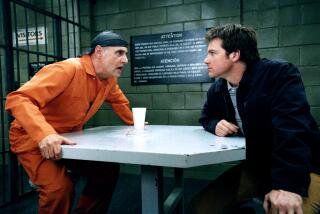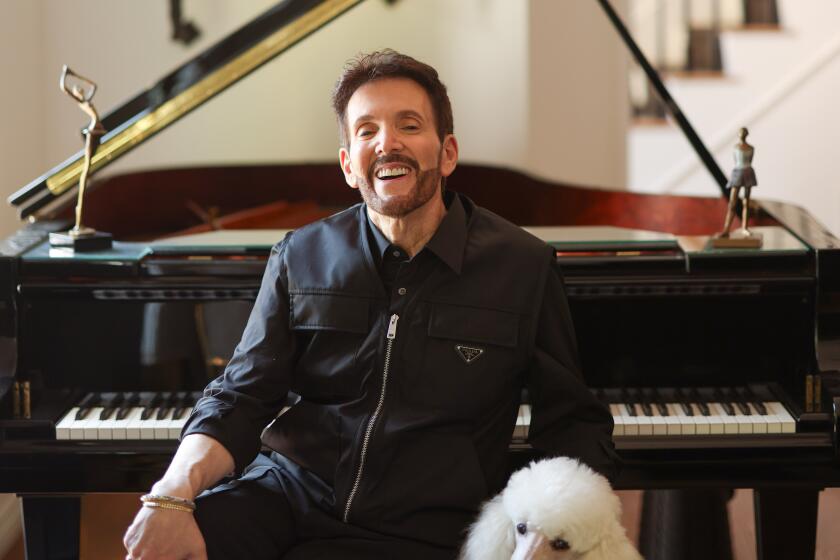Hogan: More Wonder From Down Under
- Share via
Paul Hogan, a.k.a. Mick Dundee, was sitting in his office at Paramount Pictures, knocking down some myths that have sprung up about him since the first “ ‘Crocodile’ Dundee” movie.
Dundee, of course, was the Aussie crocodile catcher who, when he was lured out of the Outback to Manhattan, proved equally skilled at capturing New Yorkers with a combination of bare hands and charm.
“Dundee” the movie almost swallowed the world’s moviegoers whole when it was released in 1986. Made by a group of first-timers for $6.6 million, it went on to gross $175 million here and $380 million worldwide.
Since then, Hogan has been back in the Outback doing more heroics for “ ‘Crocodile’ Dundee II.” It opens in the United States May 25 on a record--for a movie opening--2,500 screens.
Now at Paramount for some round-the-clock postproduction work on the movie, Hogan, 48, was looking smaller and more vivid--blonder hair, bluer eyes, deeper red-brown tan--than he does on the Big Screen.
Wearing jeans and boots, he was settled in a soft leather chair, smoking cigarettes and sounding relaxed despite the rush to finish the movie.
When a photographer asked him to pose behind the desk in the office, Hogan looked surprised. He doubted that would look “natural,” but he complied with the request, then settled back into his chair.
Hogan has made an art form of the relaxed delivery. Remember, he was first known here as the “g’day mate” in the Australian Tourist Commission commercials offering to “slip another shrimp on the barbie” for visiting Americans.
The real-life Hogan has a bit more edge. “I’m gettin’ sick of slipping a shrimp on the barbie,” he said.
Before making “Dundee,” Hogan mined the easygoing streak in the Aussie national character on his highly rated Australian TV show, “The Paul Hogan Show,” which was produced by his manager and longtime business partner John Cornell. (It aired in Los Angeles on KHJ-TV Channel 9.)
One story has it that Cornell, who is also the director of “Dundee II,” has been so anxious to preserve Hogan’s proletarian image that he asked Hogan never to be photographed reading or driving his Porsche.
Not true, said Hogan: “Nobody tells me what to do.
“The thing was,” he elaborated, “I don’t read. I’ve read about 20 books in my life.”
According to Hogan, Cornell remarked, “Well maybe you shouldn’t start readin’, it might change whatever you’re doing now.”
“That was purely it, and that turned into this thing about, oh, John wanted people to think I was ignorant.
“I’m not going to get around in a beat-up Volkswagen: ‘Look, look, I’m rich, but money hasn’t changed me.’ Oh, he must be stupid then.”
“Money’s changed me,” Hogan said. “Money changes everybody.”
Hogan’s own life story is almost as tall a tale as “Dundee,” but with darker chapters.
Raised in a working-class Sydney suburb, he dropped out of school at 15, married at 18 and worked as a truck driver, construction worker, a boxer (not a very good one, he says), and a bridge rigger, or “riggah,” in Hogan’s briny pronunciation.
And he was not happy: “I was an angry young man. I dropped out of school because I got bored with it. I hated the jobs that I had and only lived for the weekend so I could play football and be with the kids (he has five) and things like that. Now I don’t care about weekends. I don’t know when they are.”
The lack of readin’ hasn’t hurt his writin’. He co-wrote the first “Dundee” with Cornell and wrote the sequel with his son, Brett, who ordinarily operates movie lights and is a cameraman. The writing process isn’t anguishing for Hogan. “By the time I finished ‘Crocodile I,’ I had a million ideas in my head for the second one,” he said.
He’s already writing his next film with his son, a comedy in which Hogan would star as a “city person.” There’ll be no more Outback characters for now, he said, and no more “Dundees” ever. Likewise, he’ll give up doing commercials, he said, once his contract with Foster’s Lager runs its course.
“Dundee II” picks up in Manhattan with Mick and the reporter-turned-girlfriend (actress Linda Kozlowski) who lured Dundee out of Australia in the first film.
“Basically, what happens is, she gets into a lot of trouble and the way to keep her out of it is to take her back to where he comes from.”
Hogan was so self-assured in his original Australian TV performances, as a blue-collar humor editorialist, that he worked without a script: “I used to stand in front of the camera and sort of talk,” he recalls. Once he began using scripts on his own show, he wrote most of them, though the only previous writing he had done was filling out his lunch order at a work site, as he demonstrated, “Two ham and cheese sandwiches and an order of French fries.”
He’s not concerned about creating “art”: ‘We’re not in the Oscar business. That’s not what the business is about. It’s public entertainment. It’s people lined up in the street and paying money to come in and they should come out feelin’ like they had a good time, not saying, ‘Well, that picture won four Oscars but it depressed me and I didn’t like it.’ ”
He sighs: “There’s always a section of the industry in most countries that leans toward obscure, depressing and sometimes miserable films and then they pass them off as art because nobody likes them.”
Hogan was 31 when he fell into show business by going on an Australian TV show that featured amateurs.
“The object on that show was feeding Christians to the lions,” he recalls. “They had these professional entertainers who would adjudicate, pointing out what was right and wrong with the performances, but they didn’t really advise . It was just an excuse to get these poor untalented amateurs out there and tear them apart, embarrassing them and humiliating them.
“I sort of went on behalf of the people who were being bullied, to sort of say, ‘Well, let’s see you bully me,’ with no serious ambitions whatsoever. I thought it would be nice if one of the Christians jumped up and pulled the lion’s head off.”
So Hogan went on the show as a blindfolded, tap-dancing knife-thrower, then proceeded to critique the judges: “I pointed out very accurately the shortcomings of the professional entertainers and I did it in exactly the style they did it. They hated it but the crowd roared.
“It just kept on going from there. I think it was two years and I had my own show, which was the highest-rated show in the country. And I was still wonderin’ why are they doing this? Why are they paying me money?
“If you can go from begin a rigger to a television star in a matter of weeks, then going to more fame or a bigger movie is just a progression,” he said. “The only difference is you can’t escape so much. But that’s not a problem. If you can’t handle (a loss of privacy), then you shouldn’t be in the business. Stay at home and sing in the bathtub. Tell jokes to your family.”
When Hogan’s not working, he surfs. His Sydney house, the same one he had before “ ‘Crocodile’ Dundee,” is 10 minutes from seven beaches, and serves as a Kennedy-type family compound on the weekends. “We sort of play touch football or tennis or scruples or whatever. I mow the lawns.”
More to Read
Only good movies
Get the Indie Focus newsletter, Mark Olsen's weekly guide to the world of cinema.
You may occasionally receive promotional content from the Los Angeles Times.










